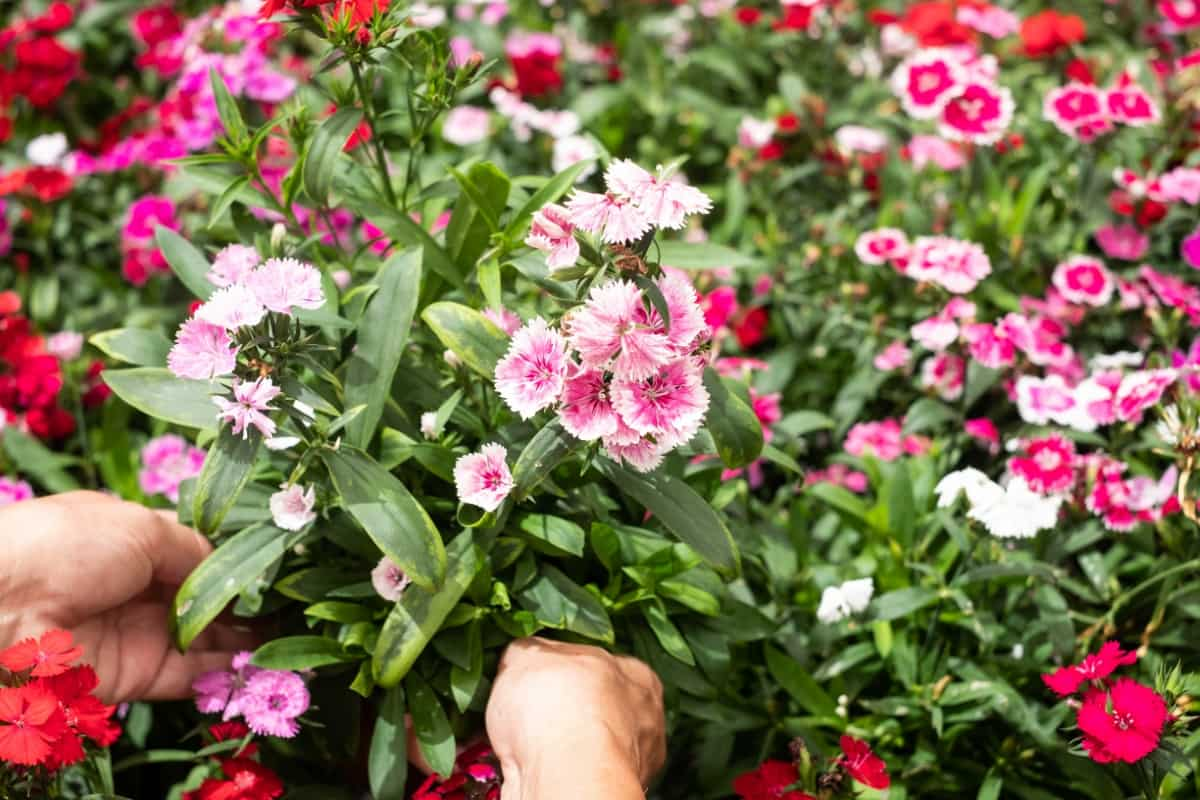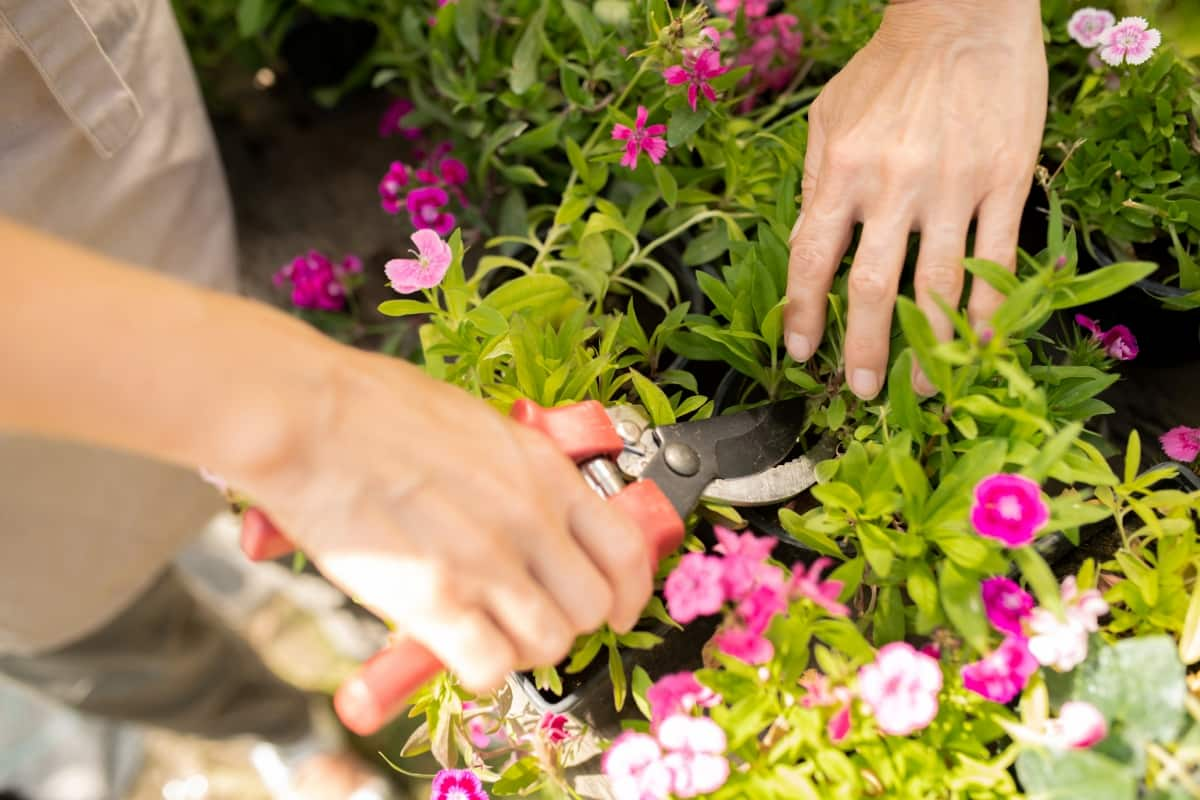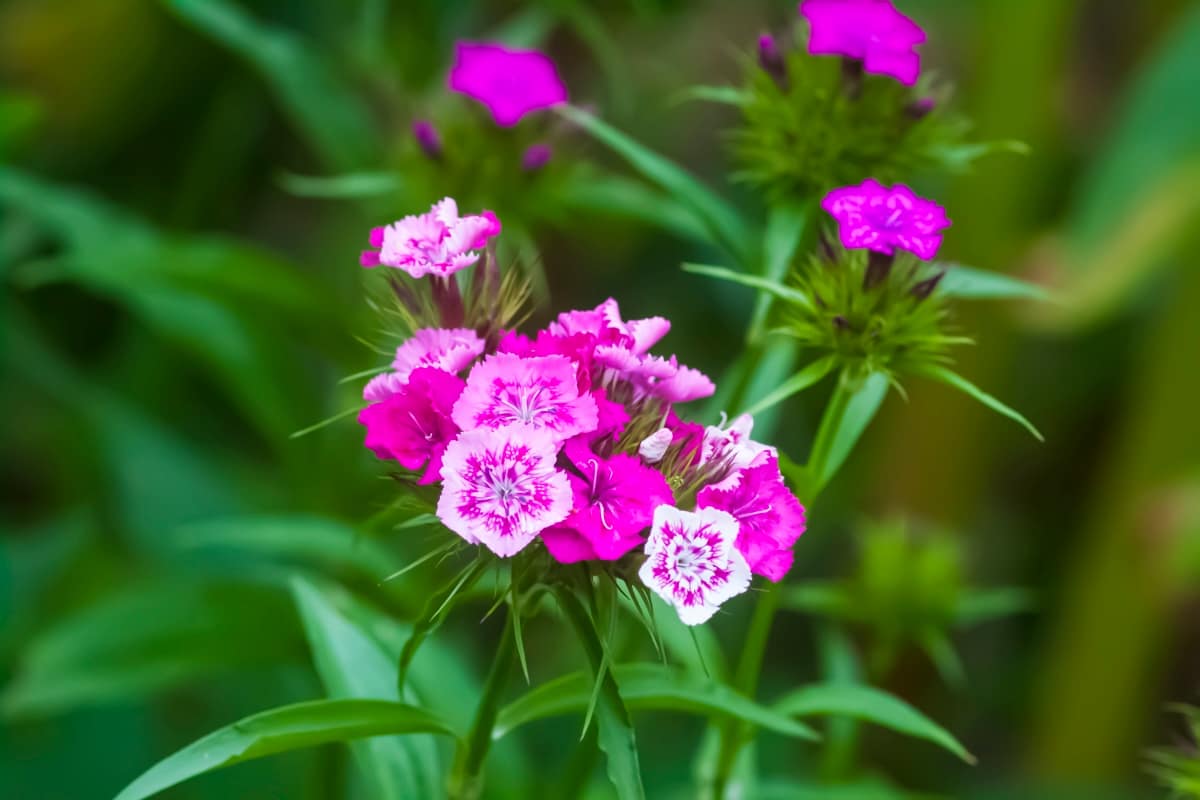A carnation is a bright, double-layered flower with silky petals in various colors. Because of their long, sturdy stems, they are popular for cut flowers. They are the January birth flower, along with Snowdrops. In addition to their long history, carnations have several symbolic meanings and symbols unique to each color.

Carnations are cultivated almost exclusively as cut flowers by florists and gardeners in greenhouses. Because they bloom between fall and spring, they provide blooms during their most valuable season.
How to Grow Carnations in a Greenhouse
Carnation Varieties Suitable for Growing in a Greenhouse
- White: White Sim, George Allwood, Purity, Northland, and Olivette.
- Pink: Pink Sim, Laddie, Donna Lee Supreme, and Sidney Littlefield.
- Scarlet: William Sim, Cardinal, King, and Scarlet Pimpernel.
- Deep Red or Crimson: Mrs. C. W. Weld, Suzanne, and Seth Parker.
- Yellow: King Midas, Miller’s Yellow, and Golden Wonder.
Climate Conditions for Carnation Growing in Greenhouse
- Daytime temperatures of about 15 – 18°C in summer, but not exceeding 21°C.
- Temperatures at night are around 10 to 12°C.
- A cooler climate reduces flower production but improves flower quality.
- The carnation can tolerate temperatures as low as -3 / -4 degrees Celsius without freezing, but the minimum temperature for vegetative growth is around 8 degrees Celsius.
- The maximum temperature is around 35ºC.
- A minimum illumination of 40,000 lux is required. Furthermore, light determines the size and number of flowers, as well as the stiffness of the stem.
- The relative humidity should be 60-70% on average.
Soil Requirements for Growing Carnation in Greenhouse
Alkaline soil, also known as sweet soil, is necessary for carnations to thrive. Generally, alkaline soil has higher calcium, magnesium, and sodium concentrations. The best way to get carnations off to a good start is to add lime to your soil when planting them.
How to Grow Carnation From Seeds in Greenhouse
- Ensure your seeds trays or small containers are filled with fine-textured and well-draining potting mix.
- Spread the seeds evenly over the soil, then lightly cover them with soil.
- A cloche, dome, or plastic bag can create a greenhouse effect by gently watering the soil until it is moist.
- It should take a few days for the seeds to germinate. Once the seeds are sprouting, remove the covers for a few hours every few days to allow the air to circulate.
- Maintain an even moisture level in the potting medium.
- After the frost danger has passed, plant seedlings in the garden once they have developed two to three leaves.
- Make sure the planting site is prepared and enriched with compost before transplanting.
- Plants should be placed so that the crown is just above the soil, then backfilled, firming the soil slightly around the roots.
- Maintain even moisture until established by watering gently and thoroughly.
- Mulch carefully and keep moisture-retentive materials away from the crown.
Watering Requirements for Growing Carnations in Greenhouse
A deep watering once a week is recommended for new plants. For establishing root systems, soaker hoses are ideal. Until the roots have established themselves, you will only need to water the flowers once the top inch of soil is completely dry. Stick to a morning watering schedule to prevent mildew on the plant’s delicate leaves during the afternoon heat.
In case you missed it: How to Grow Orchids in a Greenhouse: A Step-By-Step Guide for Seed to Harvest

Feeding Carnation Plants Growing in Greenhouse
Plan to feed your carnations by amending soil to contain enough organic matter and using a slow-release plant fertilizer if you’re growing the traditional florist-type flower. A poultry-based fertilizer or organic Plant-tone is a good fertilizer for perennial carnations in early spring.
Staking Carnations Growing in Greenhouse
When grown in a greenhouse, carnations typically produce flowers between 2 and 3 inches in diameter. Because flowers are too heavy to support stems, plants tend to be floppy, so it’s important to stake them. Using grow-through stakes or Hortonova trellis netting stretched about 12 inches above the soil makes growing carnations easier. You can also create a grid of bamboo and string, and weave carnation stems through it.
Pruning Carnation Plants Growing in Greenhouse
Plants should be pruned about one month after planting. Make your pruning cut so five pairs of leaves remain on the stem. New shoots can also be pinched using the same technique. This method produces bushy plants with many shoots, which means more blooms. Remove all but two strongest shoots from each plant’s main stem for larger flowers. Remove spent blooms after flowering. In this way, the disease cannot develop on dying petals and spread to healthy tissue.
Common Problems With Carnations
Brown Blooms and Leaves
The plants suffer from botrytis flower rot if parts of the flower are browning and papery to the touch. Browning and leaf curl can also be caused by rust and leaf spots. If any of these parts are rotted, remove them from the plant and do not water them from overhead to avoid wetting the buds and leaves too much. Plants should be spaced apart to improve air circulation.
Yellowing Leaves
Check the underside of leaves for spider mites and their fine webs if they are becoming very light yellow. Control the problem with insecticidal soap. Aphids can also cause leaf discoloration.
Holes in Buds
These holes are likely the result of cutworms feeding on the buds. Eventually, plants will need protection or pesticides (as a last resort).
Wilting and Split Stems
The plants may have contracted bacterial wilt, which is more common in young plants. Dispose of diseased parts with a well-sterilized cutting tool to prevent the disease’s spread. Continue to be cautious when watering to avoid splashing buds or leaves. Wilting can also be caused by root rot, which leads to yellow leaves and imminent death.
Harvesting Carnation Flowers
Pick blooms when half-opened or, with spray types with several flowers per stem, when one or two of the flowers are open. Early morning or evening is the best time to pick after the dew has dried. After picking, the stems should be recut underwater and placed in cool water overnight. It is called conditioning the flowers.
In case you missed it: How to Grow Geranium in a Greenhouse: A Step-by-Step Guide for Seed to Harvest

During this time, the stems will absorb water and become fully hydrated. Recutting stems underwater is recommended. Using commercial flower preservatives in the vase is recommended to prolong the flower’s life by up to two weeks.
Conclusion
Carnations must be grown under protected structures to maintain their quality and yield. Simple greenhouse construction is best but must meet a few elementary requirements to maintain a favorable climate. The greenhouse should also be able to roll up the sides and not be too big (maximum 100x50m = 5000 m2 per unit) to maintain good climate control.
- Feed Your Flock for Less: Top 10 Tips to Save on Chicken Feed
- Ultimate Guide to Ossabaw Island Hog: Breeding, Raising, Diet, and Care
- Hatching Answers: The Top 10 Reasons Your Chickens Aren’t Laying Eggs
- Eggs and Economics: Breaking Down the Cost of Raising Backyard Chickens
- Defend Your Greens: Proven Methods to Keep Iguanas Out of Your Garden
- Ultimate Guide to Cinnamon Queen Chicken: A Comprehensive Guide for Beginners
- Ultimate Guide to California Tan Chicken: Breeding, Raising, Diet, Egg-Production and Care
- Ultimate Guide to Marsh Daisy Chicken: Breeding, Raising, Diet, and Care
- 10 Types of Chicken Farming Businesses You Can Start for Profits